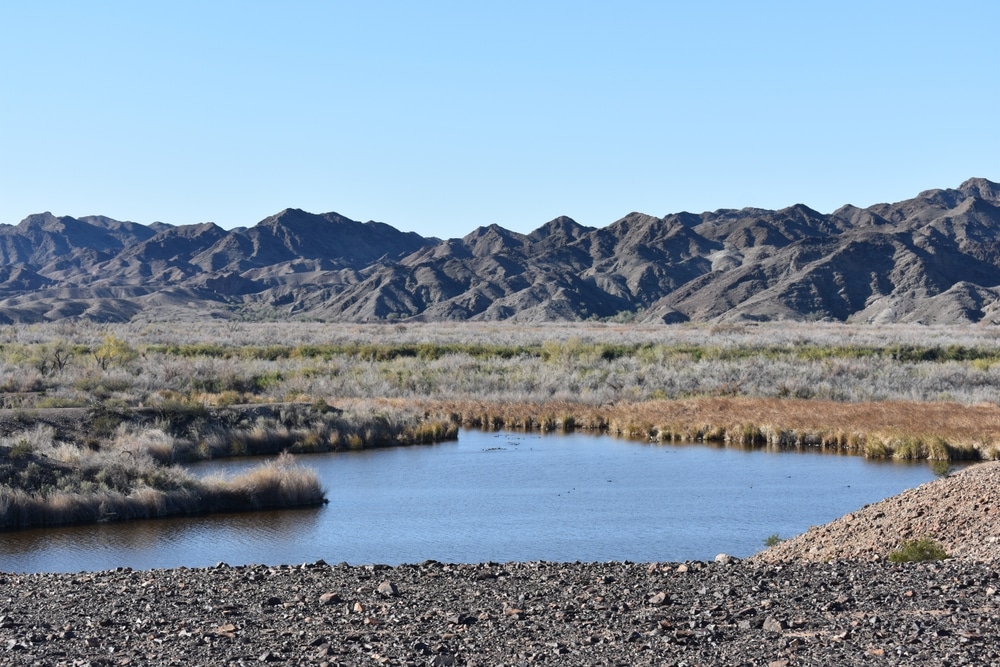Tucked away in Arizona’s southwestern corner where the state borders California, Imperial National Wildlife Refuge protects one of the last wild stretches of the lower Colorado River, creating a remarkable haven where desert meets water. Established in 1941, this 25,768-acre sanctuary encompasses a diverse mosaic of habitats—from the life-giving river itself to backwater lakes, wetlands, desert washes, and rugged mountainous terrain. Unlike Arizona’s more famous Grand Canyon to the north, where the Colorado River cuts dramatically through towering cliffs, Imperial Refuge showcases the river in its gentler southern flow, where it creates a green ribbon of life through an otherwise harsh desert landscape.
The refuge’s ecological significance cannot be overstated. As intensive water management and development have transformed much of the Colorado River system, Imperial stands as a vital reminder of the river’s natural character and ecological importance. Here, native cottonwood and willow forests still grace the riverbanks, providing critical habitat for numerous wildlife species that depend on these increasingly rare riparian zones. Beyond the river corridor, the refuge showcases classic Sonoran Desert landscapes, with saguaro cacti dotting rocky hillsides and desert washes cutting through arid terrain.

The Imperial National Wildlife Refuge Visitor Center provides a great starting point for your visit. It offers:
The refuge is a haven for wildlife enthusiasts. Its wetlands, riparian habitats, and desert terrain support a variety of species, including:

The refuge offers several trails that allow visitors to explore its diverse habitats:

The Colorado River and its backwaters provide excellent opportunities for fishing and boating. Anglers can catch species such as:

The refuge’s mix of wetlands, desert landscapes, and abundant wildlife make it a paradise for photographers. Capture:

Several scenic overlooks in the refuge provide breathtaking views of the Colorado River and its surrounding wetlands. These spots are perfect for photography, birdwatching, or simply enjoying the peaceful beauty of the area. Popular overlooks include:

Hunting is permitted in designated areas of the refuge during specific seasons, in accordance with state and federal regulations. Popular species for hunting include dove, quail, and waterfowl. Hunters must have the appropriate licenses and follow all rules specific to the refuge.
| Category | Details |
|---|---|
| Location | Southwestern Arizona and southeastern California, along the Colorado River |
| Established | February 14, 1941 |
| Managed By | U.S. Fish and Wildlife Service |
| Size | Approximately 25,768 acres (10,429 hectares) |
| Main Attractions | Wetlands, desert landscapes, wildlife observation points, and scenic overlooks |
| Ecosystem | Unique mix of wetlands, riparian areas, and Sonoran Desert habitat |
| Wildlife | Home to over 275 bird species (e.g., great blue herons, bald eagles), mule deer, bobcats, and fish species like razorback suckers and bonytail chub |
| Cultural Significance | Includes ancient Native American sites and historical remnants along the Colorado River |
| Recreation Activities | Boating, fishing, hiking, birdwatching, nature photography, and hunting (in designated areas) |
| Popular Areas | – Painted Desert Trail: A 1.3-mile loop through colorful desert landscapes- Observation Tower: Offers panoramic views of the wetlands and surrounding area |
| Nearby Landmarks | Yuma, Martinez Lake, Cibola National Wildlife Refuge |
| Climate | Hot summers and mild winters, typical of the low desert, with minimal rainfall |
| Camping | Limited camping is available at nearby recreation areas, such as Martinez Lake |
| Accessibility | Visitor center and some trails are wheelchair accessible |
| Entrance Fee | No entrance fee |
| Fun Fact | The refuge protects one of the last unaltered sections of the lower Colorado River, providing critical habitat for endangered fish and birds. |
For visitors, Imperial National Wildlife Refuge offers a unique opportunity to experience the sharp contrast between desert and riparian ecosystems. Within a single day, one can paddle quiet backwaters teeming with waterfowl, hike through stark desert landscapes dotted with wildflowers after spring rains, and witness spectacular sunsets from scenic overlooks where mountains meet the river valley. The refuge’s relatively remote location—approximately 40 miles north of Yuma—means fewer crowds than many of Arizona’s public lands, providing opportunities for solitude and uninterrupted connection with nature.
Beyond its recreational value, Imperial plays a crucial role in broader conservation efforts along the lower Colorado River. As part of a network of protected areas including Havasu and Cibola National Wildlife Refuges, it helps maintain ecological connectivity in an increasingly fragmented landscape. For both wildlife and human visitors, Imperial National Wildlife Refuge stands as a testament to the transformative power of water in the desert Southwest—a power clearly visible in the stark contrast between lush riverside habitats and the surrounding arid lands.
The defining feature of Imperial National Wildlife Refuge is undoubtedly the Colorado River, which flows for approximately 30 miles through the refuge. Unlike its swift current through the Grand Canyon, here the river adopts a more leisurely pace, creating a complex system of main channels, backwaters, oxbow lakes, and marshes. This diversity of aquatic habitats supports an equally diverse community of fish, birds, and other wildlife.
Prior to human intervention, the Colorado River was a dynamic system characterized by seasonal flooding that continuously reshaped the landscape, creating new channels and backwaters while depositing nutrient-rich sediments across the floodplain. Today, upstream dams have largely eliminated these natural flood cycles, and the river flows under carefully regulated management. Despite these alterations, the stretch within Imperial Refuge maintains significant ecological value, with refuge managers working to mimic natural processes through controlled water management.
The river corridor supports some of the most important remaining stands of native riparian vegetation along the lower Colorado. Cottonwood and willow galleries create vertical structure in an otherwise horizontal landscape, providing crucial nesting habitat for numerous bird species. The interface between aquatic and terrestrial habitats creates particularly rich edge environments where visitors often observe the greatest wildlife diversity.
Perhaps the most ecologically productive areas within Imperial Refuge are its wetlands and backwaters. These quiet waters—partially separated from the main river channel—create protected habitats for aquatic plants, invertebrates, fish, and water-dependent birds. Emergent vegetation such as cattails and bulrushes provide cover for secretive marsh birds, while submerged aquatic plants offer food for waterfowl and habitat for fish.
Particularly noteworthy is Meers Point, where a major backwater creates excellent wildlife viewing opportunities. Here, visitors often observe ducks, grebes, herons, and other waterbirds from an accessible viewing platform. During winter months, these waters host impressive concentrations of migratory waterfowl that have traveled the Pacific Flyway to reach these southern feeding grounds.
Throughout the refuge, wetland management focuses on maintaining habitat diversity. Some areas feature open water for diving ducks and fish, while others are managed for shallow conditions preferred by dabbling ducks and shorebirds. This mosaic approach maximizes biodiversity within the limited water resources available.
Beyond the river’s influence, Imperial Refuge encompasses significant desert upland habitats that showcase the stark beauty of the Sonoran Desert. Several small mountain ranges including the Chocolate Mountains and the Trigo Mountains rise dramatically from the river valley, creating rugged landscapes characterized by volcanic cliffs, deep canyons, and alluvial fans.
These uplands support classic Sonoran Desert plant communities adapted to extreme aridity and heat. Creosote bush and white bursage dominate the lower elevations, while rocky slopes host ocotillo, cholla, barrel cactus, and the iconic saguaro. Desert washes—dry most of the year but occasionally flowing after rains—support denser vegetation including ironwood, palo verde, and mesquite trees that provide valuable wildlife habitat.
The transition zones between riparian areas and desert uplands create particularly rich ecological edge habitats. Here, species from both ecosystems interact, often resulting in wildlife “hotspots” that reward observant visitors. These transitions also offer some of the most scenic vistas in the refuge, where visitors can appreciate the dramatic contrast between the green river corridor and the surrounding desert.
One of the refuge’s most distinctive geological features is accessible via the Painted Desert Trail. This moderate 1.3-mile loop showcases colorful sedimentary formations created millions of years ago when the area lay beneath a vast inland sea. Subsequent uplifting and erosion have exposed these layers of red, white, lavender, and brown sediments, creating a landscape reminiscent of the more famous Painted Desert in northern Arizona.
The trail winds through badlands-type terrain where erosion has carved fantastical shapes from the soft sedimentary deposits. Interpretive signs explain the geological processes visible in the surrounding landscape while identifying characteristic desert plants that have adapted to this harsh environment. From higher points along the trail, hikers gain sweeping views of the river valley and distant mountains, providing perspective on how the region’s topography influences its ecosystems.
Imperial National Wildlife Refuge hosts an impressive diversity of bird life, with more than 275 species documented within its boundaries. This avian richness results from the refuge’s habitat diversity and its strategic location along the Pacific Flyway, one of North America’s major bird migration corridors.
The riparian forests along the Colorado River support numerous breeding birds, including colorful summer residents like vermilion flycatchers, summer tanagers, and yellow-breasted chats. Cavity-nesting species such as Gila woodpeckers and ash-throated flycatchers utilize older trees, while yellow warblers and Bell’s vireos nest in the dense understory. Magnificent raptors including peregrine falcons, bald eagles, and osprey can be observed hunting along the river, particularly during winter months.
The refuge’s wetlands and backwaters attract an entirely different bird community. Great blue herons, snowy egrets, and black-crowned night-herons stalk the shallows for fish, while dabbling ducks such as mallards, northern pintails, and green-winged teal feed on aquatic vegetation. During winter, these waterfowl are joined by American coots, common mergansers, and various grebes. Secretive marsh species including soras, Virginia rails, and American bitterns hide among the cattails, challenging even experienced birders to spot them.
Desert upland areas host specialized bird species adapted to arid conditions. Curve-billed thrashers, black-tailed gnatcatchers, and black-throated sparrows find shelter in desert shrubs, while Gambel’s quail scurry through the understory in coveys. Distinctive cactus specialists such as Gila woodpeckers and gilded flickers excavate nest cavities in saguaro cacti, providing homes not only for themselves but also for secondary cavity-nesters like elf owls and western screech-owls.
During migration periods (March-May and September-October), the refuge experiences dramatic increases in bird diversity as neotropical migrants move between summer and winter territories. Warbler species, flycatchers, tanagers, and orioles pass through in impressive numbers, creating excellent birdwatching opportunities during these transitional seasons.
Despite challenging conditions, Imperial Refuge supports a diverse mammal community adapted to desert and riparian environments. Desert bighorn sheep represent one of the refuge’s most charismatic large mammals. These agile ungulates navigate the steep slopes of the Chocolate and Trigo Mountains, descending occasionally to drink at the river. Patient observers may spot them silhouetted against rocky ridgelines, particularly during early morning or late afternoon hours.
More commonly encountered mammals include desert mule deer, which favor the lusher vegetation along washes and the river corridor. Smaller herbivores such as desert cottontails, black-tailed jackrabbits, and round-tailed ground squirrels are frequently observed, particularly near dawn and dusk when they actively feed.
The refuge hosts several predator species including bobcats, gray foxes, and coyotes. These animals are typically most active during cooler nighttime hours, though lucky visitors occasionally spot them during early morning. Smaller predators include ringtails, spotted skunks, and the seldom-seen kit fox—a desert specialist with oversized ears that help dissipate heat.
Beavers and muskrats inhabit waterways within the refuge, their activities helping to maintain wetland habitats. Beaver dams and lodges can be observed along backwaters, where they create valuable habitat diversity. Several bat species roost in caves and rock crevices within the refuge’s mountainous areas, emerging at dusk to feed on insects above the river and wetlands.
The Sonoran Desert boasts one of North America’s richest reptile faunas, and Imperial Refuge showcases this diversity. Desert adaptations are particularly evident among reptile species, which have evolved remarkable strategies for surviving in this challenging environment.
Desert tortoises, listed as a threatened species, find habitat in the refuge’s upland areas. These long-lived reptiles spend much of their time in underground burrows to escape extreme temperatures, emerging to feed during more moderate conditions and after seasonal rains trigger plant growth. Side-blotched lizards, western whiptails, and zebra-tailed lizards dart across open ground between shrubs, while chuckwallas wedge themselves into rock crevices when threatened, inflating their bodies to prevent extraction by predators.
The refuge hosts several snake species including coachwhips, glossy snakes, and the venomous Mohave and western diamondback rattlesnakes. These reptiles play important ecological roles as both predators and prey, helping to regulate rodent populations while providing food for raptors and mammalian carnivores.
Near water sources, visitors might encounter Sonoran mud turtles, which inhabit permanent pools in the river and backwaters. Amphibians include several species of toads and frogs that become particularly active during and after summer monsoon rains. The distinctive call of the Colorado River toad (also known as the Sonoran Desert toad) characterizes warm summer evenings near water.
The Colorado River and its associated backwaters support diverse aquatic communities, though these have been significantly altered by introduced species and changes in river conditions. Historically, the Colorado River system hosted several endemic fish species evolved to handle its unique conditions of high sediment loads, fluctuating flows, and extreme seasonal temperature variations.
Today, native fish face serious challenges throughout the system, but Imperial Refuge participates in conservation efforts for several species including the endangered razorback sucker and bonytail chub. These distinctive fish, characterized by adaptations to historic river conditions, now receive intensive management attention including captive breeding and reintroduction programs.
More commonly encountered fish include introduced sport species such as largemouth bass, bluegill, and channel catfish. While non-native, these fish provide recreational opportunities and have established self-sustaining populations in refuge waters. Striped bass occasionally move upstream from Imperial Reservoir, particularly during spawning seasons.
The refuge’s slower backwaters host diverse invertebrate communities including dragonfly nymphs, water beetles, and freshwater crustaceans that provide food sources for fish, birds, and other wildlife. These less conspicuous components of the ecosystem play crucial roles in nutrient cycling and energy transfer through the food web.
With 30 miles of Colorado River flowing through its boundaries, Imperial National Wildlife Refuge offers outstanding water-based recreation opportunities. These range from motorized boating in the main channel to peaceful paddling experiences in secluded backwaters.
For motorized boating, several launch sites provide access to the river. Popular launch locations include:
Once on the water, boaters can explore the main river channel while watching for wildlife along shorelines and in backwaters. Fishing is popular from boats, with anglers targeting largemouth bass, channel catfish, and other sport fish. Refuge regulations limit speed and noise in certain sensitive wildlife areas, particularly during nesting seasons.
For those seeking quieter experiences, canoeing and kayaking offer intimate connections with refuge habitats. Paddlers can explore backwaters inaccessible to larger boats, often encountering wildlife at close range. Popular paddling routes include:
The best paddling seasons are fall through spring when temperatures are moderate. Summer conditions can be dangerously hot, with water offering little relief as surface temperatures often exceed 80°F. Paddlers should always carry adequate water and sun protection regardless of season.
Imperial Refuge maintains several developed trails that showcase different habitats and offer varying difficulty levels:
Painted Desert Trail: This moderate 1.3-mile loop highlights colorful geological formations and desert plant communities. Interpretive signs explain natural and cultural history features. Best hiked in morning or late afternoon during warmer months.
Ironwood Loop: A relatively easy 1-mile trail through desert wash habitat dominated by ironwood and palo verde trees. Particularly beautiful during spring wildflower season.
Lighthouse Rock Trail: For more adventurous hikers, this challenging 5-mile round-trip route climbs into the Trigo Mountains, offering spectacular panoramic views of the river valley and surrounding desert. Requires good fitness and proper preparation, particularly regarding water.
Red Cloud Mining Road: This former mining access road provides a relatively level 4-mile route through desert terrain, suitable for casual walking and wildlife observation.
Trail conditions vary seasonally, with summer presenting serious heat challenges (temperatures regularly exceed 110°F). Winter and spring offer the most comfortable hiking conditions, with moderate temperatures and the possibility of wildflower displays following winter rains. Regardless of season, hikers should carry adequate water (minimum one gallon per person per day in warmer months), wear sun protection, and inform someone of their planned route and return time.
Wildlife observation represents the premier recreational activity at Imperial, with several developed facilities enhancing these opportunities:
For photographers, the refuge offers diverse subject matter throughout the year. Dawn and dusk provide the most favorable lighting conditions while coinciding with periods of heightened wildlife activity. Winter months generally offer the greatest diversity of visible wildlife, particularly birds, though spring brings dramatic wildflower displays following adequate winter rainfall.
Photography tips for visitors include:
Consistent with the wildlife-dependent recreational priorities of the National Wildlife Refuge System, Imperial permits regulated hunting for several species:
Migratory Birds: Designated areas allow hunting for ducks, geese, and mourning doves during established seasons.
Quail: Gambel’s quail hunting is permitted in specific upland areas away from the river.
Desert Bighorn Sheep: Extremely limited permits (typically 1-2 annually) are available through Arizona Game and Fish Department’s special draw system.
All hunting requires appropriate Arizona hunting licenses and adherence to both state and refuge-specific regulations. Hunter education programs emphasize ethical practices and conservation principles.
Fishing represents another popular activity, with anglers targeting several species:
Shore fishing is possible at several access points, though boats provide access to more productive areas. Arizona fishing licenses are required, and special regulations may apply to certain species. The refuge encourages catch-and-release practices, particularly for larger bass that serve as breeding stock.
Imperial National Wildlife Refuge experiences the classic climate pattern of the Sonoran Desert—extremely hot summers and mild winters. This dramatic seasonal variation strongly influences both wildlife activity and visitor experiences:
Winter (November-February): The premier season for visiting Imperial, with comfortable daytime temperatures ranging from 65-75°F and cool nights that may drop into the 40s. Wildlife reaches peak abundance, particularly migratory birds. This period offers the best combination of pleasant weather and wildlife viewing opportunities.
Spring (March-April): A transitional season with warming temperatures (75-95°F) and the possibility of spectacular wildflower displays if winter rains have been adequate. Spring migration brings many bird species through the refuge. April generally marks the beginning of hot conditions.
Summer (May-September): Characterized by extreme heat, with daytime temperatures consistently exceeding 105°F and occasionally reaching 120°F. Wildlife activity shifts to nighttime and early morning hours. Visitor services are limited during this challenging season, and outdoor activities require serious heat precautions.
Fall (October-early November): Another transitional season as temperatures moderate and early migrants begin arriving. The landscape appears particularly arid during this period, as it comes at the end of the long dry summer.
Given these patterns, most visitors choose to explore Imperial between November and March, with December through February offering the fullest wildlife experience combined with comfortable conditions.
For planning purposes, visitors should consider this general wildlife calendar:
Special wildlife events include:
The summer monsoon season (typically July through September) brings dramatic changes to the refuge. While this period generally coincides with challenging heat, the increased humidity and occasional thunderstorms create unique conditions:
Flash Flood Potential: Desert washes can transform from dry paths to raging torrents within minutes. Never camp in washes or attempt to cross flowing water.
Road Conditions: Unpaved refuge roads may become impassable when wet. Check conditions at the visitor center before venturing onto these routes.
Wildlife Activity: Brief increases in wildlife activity often follow rain events as animals emerge to take advantage of temporary water sources and increased plant growth.
Humidity: Unlike the dry heat of early summer, monsoon conditions bring higher humidity that can make heat exposure more dangerous by reducing the body’s cooling efficiency.
Despite these challenges, monsoon season offers unique opportunities to observe desert adaptation at work as plants and animals respond to the brief availability of water in this arid environment.
Imperial National Wildlife Refuge is located in southwestern Arizona, approximately 40 miles north of Yuma and 25 miles south of Parker. Primary access is via Martinez Lake Road, which connects to Highway 95 near the community of Bard.
From Yuma:
From Phoenix:
Internal navigation relies on a limited network of roads that access various refuge features. The main refuge road is paved for approximately 3 miles before transitioning to improved gravel. Several secondary roads require high-clearance vehicles, and some may become impassable after rain events. A detailed map, available at the visitor center, is essential for exploring beyond the main areas.
Imperial maintains basic visitor facilities centered around the refuge headquarters area:
Visitor Center: Open weekdays and weekends during peak season (November-March). Offers informational displays about refuge wildlife and habitats, helpful staff, restrooms, and limited educational materials. Closed on federal holidays.
Painted Desert Overlook: Adjacent to the visitor center, this accessible viewing area provides orientation to the refuge landscape and spotting scopes for wildlife observation.
Picnic Areas: Located near the visitor center and at trailheads, offering shaded tables for day use. No overnight camping is permitted on the refuge proper.
Beyond these developed facilities, amenities are limited. Visitors should come prepared with adequate food, water, and supplies, as no commercial services exist within the refuge boundaries. The Martinez Lake area adjacent to the refuge offers limited services including a small store, boat rentals, and rustic lodging. More comprehensive services are available in Yuma, approximately one hour’s drive south.
The refuge strives to accommodate visitors with varying abilities:
Visitors with specific accessibility requirements should contact the refuge office in advance for current information and recommendations tailored to their needs.
The Colorado River corridor has supported human communities for thousands of years, serving as a lifeline in the desert environment. Archaeological evidence indicates extensive use by several indigenous cultures, including ancestors of today’s Quechan, Cocopah, and Chemehuevi peoples.
The river provided not only water but also fertile floodplains for agriculture, fish and wildlife for food, and plants for medicine, tools, and shelter. Ancient trails connected river settlements with resources in surrounding mountains and desert areas, creating a complex cultural landscape still visible to knowledgeable observers.
Today, several Native American nations maintain connections to these ancestral lands. The refuge consults with affiliated tribes regarding management practices that may affect cultural resources or traditional use areas. Visitors should respect cultural sites and artifacts, which are protected by federal law.
The mountains within and surrounding Imperial Refuge have a rich mining history dating back to the 1800s. Prospectors searched these rugged ranges for gold, silver, lead, and copper, establishing small operations that came and went with mineral prices and technological capabilities.
Evidence of this mining heritage remains visible in abandoned adits (horizontal mine entrances), tailings piles, and the remnants of processing equipment. The Red Cloud Mine in the Trigo Mountains represents one of the better-known historical operations, having produced significant quantities of silver and lead during its active periods.
For safety and resource protection reasons, visitors should observe mining remains from a distance rather than entering structures or tunnels. These features provide important historical context while also offering habitat for bats and other wildlife that have adapted to these human-created spaces.
The Colorado River has served as a transportation corridor since prehistoric times, with various cultures utilizing its waters for travel and trade. European exploration intensified in the mid-1800s, with steamboats eventually navigating portions of the lower Colorado to supply mining operations and military outposts.
The modern era of river development began with the construction of major dams—most notably Hoover Dam (1936) and Imperial Dam (1938)—that transformed the once-wild Colorado into a managed system of reservoirs and regulated flows. These projects dramatically altered downstream ecosystems by capturing sediment, controlling floods, and modifying natural temperature and flow patterns.
Imperial National Wildlife Refuge emerged as part of the response to these massive water projects, representing an acknowledgment of the ecological costs of river development. Today, the refuge demonstrates both the challenges of maintaining riparian ecosystems in a highly managed river system and the potential for protecting critical wildlife habitat within these constraints.
The fundamental conservation challenge at Imperial revolves around water—its availability, quality, and distribution. Operating within the complex legal framework of Colorado River water rights, the refuge must efficiently utilize its limited allocation to maximize wildlife benefits:
The refuge employs adaptive management approaches that adjust water use based on monitoring results and changing conditions. Partnerships with other agencies and organizations help leverage limited resources toward common goals of maintaining riparian and wetland habitats along the lower Colorado.
Like many southwestern ecosystems, Imperial battles several invasive species that threaten to transform natural communities:
Salt Cedar (Tamarisk): This Eurasian shrub has invaded thousands of acres along the Colorado River, displacing native vegetation and altering soil chemistry. Refuge efforts include mechanical removal, targeted herbicide application, and biological control through the salt cedar leaf beetle, which defoliates these invasive trees.
Giant Reed (Arundo donax): Forming dense stands along waterways, this invasive grass consumes enormous quantities of water while providing minimal wildlife habitat value. Control efforts focus on early detection and rapid response to new infestations.
Quagga Mussels: These aquatic invaders attach to hard surfaces in the Colorado River system, altering water chemistry and food webs while damaging infrastructure. Prevention efforts focus on boat inspection programs to limit further spread.
The refuge’s invasive species work exemplifies the challenges of ecological restoration in highly altered systems, where complete removal of exotic species may be unrealistic, but targeted management can maintain functioning ecosystems that support native wildlife.
Beyond ongoing management, Imperial implements specific restoration projects targeting high-priority habitats:
Native Tree Restoration: Active planting programs reestablish cottonwood and willow galleries in appropriate areas, creating the vertical structure required by many riparian bird species.
Mesquite Bosque Enhancement: Historic mesquite woodlands receive protective management to preserve these increasingly rare habitat types that support diverse wildlife communities.
Backwater Reconstruction: Engineering projects recreate river backwaters that provide critical habitat for native fish and refill historic river channels with permanent water.
These restoration efforts demonstrate a shift from merely preserving existing habitat to actively rebuilding ecosystem components lost to development—a necessary approach in a landscape where natural processes have been fundamentally altered.
The lower Colorado River region faces significant challenges from climate change, with projections indicating higher temperatures, altered precipitation patterns, and increased water stress. Refuge management incorporates these considerations into long-term planning:
These forward-looking strategies reflect the reality that conservation in the 21st century must anticipate and adapt to changing climate conditions rather than simply preserving historical patterns.
Visitors to Imperial National Wildlife Refuge should be aware of the following regulations:
While camping is not permitted on the refuge proper, overnight camping is available at adjacent Martinez Lake Recreation Area and at Fisher’s Landing, both of which provide access to the refuge. Special use permits may be required for certain activities, including commercial photography, organized group events, and research projects.
The remote location and desert environment present several safety considerations for visitors:
Heat Safety: Summer temperatures regularly exceed 110°F. Even in cooler seasons, visitors should carry adequate water (at least one gallon per person per day in warmer months), wear sun protection, and plan activities for cooler morning hours.
Navigation: Cell service is limited or non-existent in many areas of the refuge. Carry detailed maps and ensure someone knows your itinerary when exploring remote sections.
Wildlife Awareness: Respect wildlife from a distance. Rattlesnakes are present throughout the refuge, particularly during warmer months—stay on established paths and remain vigilant when walking in brushy areas.
Water Hazards: The Colorado River has strong currents that can be deceptively dangerous. Backwaters and irrigation canals present additional drowning hazards. Always wear life jackets when boating and supervise children near water.
Visitors are encouraged to practice Leave No Trace principles to preserve the refuge’s natural qualities:
The refuge offers various opportunities for visitors to contribute to conservation efforts:
Contact the refuge headquarters for current volunteer opportunities
Imperial National Wildlife Refuge preserves a vital piece of the lower Colorado River ecosystem, protecting critical habitat in a region where such areas have diminished dramatically. Through thoughtful management and restoration efforts, the refuge demonstrates how conservation can succeed even within highly altered landscapes, providing essential wildlife habitat while offering visitors opportunities to connect with the natural world.
For visitors, Imperial offers a unique window into the ecological contrasts that define the southwestern borderlands. The juxtaposition of desert and river creates compelling visual drama while supporting remarkable biodiversity. Whether paddling quiet backwaters, hiking desert trails, or simply observing wildlife from scenic overlooks, visitors experience firsthand the transformative power of water in arid landscapes.
Looking toward the future, Imperial faces significant challenges, particularly regarding water resources in an increasingly arid Southwest. Yet the refuge’s adaptive management approaches and restoration successes demonstrate resilience and commitment to conservation values. By balancing human needs with wildlife requirements, Imperial exemplifies how thoughtful stewardship can maintain ecological integrity even within complex managed systems.
Ultimately, Imperial National Wildlife Refuge invites visitors to discover the intimate connection between water and life in the desert Southwest. Whether watching waterfowl against a sunset sky, photographing blooming cacti against mountain backdrops, or simply appreciating the sound of wind through riverside cottonwoods, visitors leave with a deeper appreciation for these special places where river meets desert—and for the conservation efforts that ensure they remain for future generations.
Note: Always check with the refuge headquarters for the most current information regarding access, wildlife viewing opportunities, and special programs before planning your visit.